Underground homes excel at temperature regulation by leveraging Earth's natural insulation properties. The surrounding soil acts as a massive thermal mass, absorbing and storing heat energy to maintain stable temperatures year-round. At depths of 10 feet or more, ground temperatures remain constant between 50-60°F (10-15°C), providing a consistent baseline for indoor climate control. This natural insulation shields your home from extreme weather conditions, reducing temperature fluctuations and minimizing the need for artificial heating and cooling. You'll enjoy enhanced comfort, improved energy efficiency, and lower utility costs. Discover how this innovative housing solution can revolutionize your living experience and environmental impact.
Earth's Natural Insulation Properties
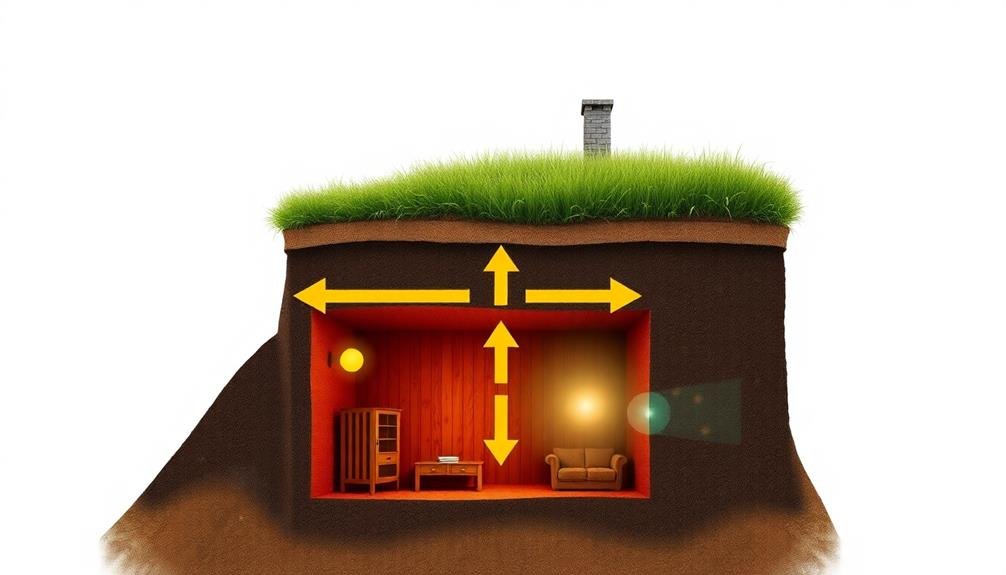
Earth's crust acts as a natural temperature regulator, providing consistent insulation for underground structures. When you build a home underground, you're taking advantage of the earth's ability to maintain a relatively stable temperature year-round. This phenomenon is due to the soil's thermal mass, which absorbs and stores heat energy.
As you go deeper into the earth, you'll find that temperature fluctuations become less pronounced. At a depth of about 10 feet, the ground temperature remains nearly constant, typically ranging between 50-60°F (10-15°C) in most regions. This natural insulation effect means your underground home won't experience the same extreme temperature swings as above-ground structures.
The earth's insulation properties work both ways. In summer, it shields your home from intense heat, while in winter, it protects against freezing temperatures. This results in considerably reduced heating and cooling needs, leading to lower energy costs and a smaller carbon footprint.
You'll find that the earth's natural insulation can help maintain a comfortable living environment with minimal mechanical intervention, making underground homes an energy-efficient and sustainable housing option.
Consistent Subterranean Temperatures
One of the most notable advantages of underground homes is their consistent internal temperature. You'll find that subterranean dwellings maintain a steady climate year-round, typically ranging between 50-60°F (10-15°C). This consistency is due to the earth's thermal mass, which absorbs and releases heat slowly.
Living underground, you'll experience:
- Reduced temperature fluctuations
- Lower energy costs for heating and cooling
- Improved comfort levels throughout the year
- Protection from extreme weather events
You won't have to worry about sudden temperature changes or the need for constant thermostat adjustments. The earth's natural insulation properties work to your advantage, creating a buffer against external temperature variations.
In summer, your home will stay cool without excessive air conditioning, while in winter, it'll remain warm with minimal heating.
This consistent temperature also means you'll save considerably on energy bills. Your HVAC system won't need to work as hard to maintain a comfortable living environment.
Additionally, you'll be less affected by power outages or extreme weather events that can impact above-ground homes' temperature regulation.
Underground living offers a stable, energy-efficient solution for year-round comfort.
Reduced External Weather Impact
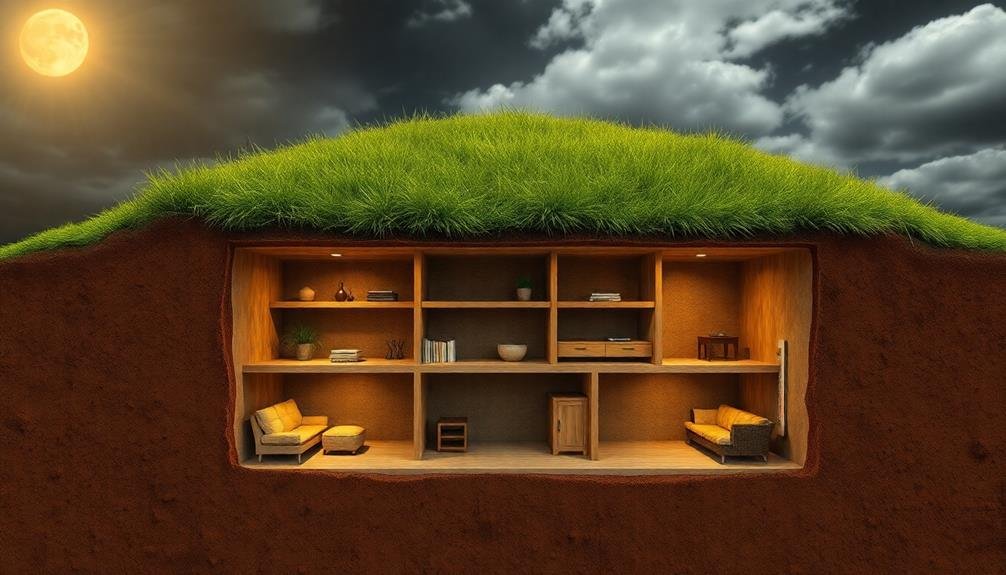
Shielded from the elements, underground homes offer significant protection against external weather conditions.
You'll find that these structures are less affected by the extremes of hot summers and cold winters. The earth surrounding your underground home acts as a natural insulator, reducing the impact of temperature fluctuations above ground.
You won't have to worry about strong winds, hail, or severe storms damaging your roof or exterior walls. The soil absorbs much of the noise from outside, creating a quieter living environment.
This protection extends to UV radiation as well, preserving your home's interior from sun damage.
In areas prone to tornadoes or hurricanes, you'll have an added layer of safety. The reduced surface area exposed to these powerful forces means your home is less likely to sustain damage.
You'll also find that underground homes require less maintenance due to minimal exposure to weathering elements.
During extreme weather events, you'll benefit from more stable indoor temperatures. This means you're less likely to experience power outages or heating and cooling system failures that can make above-ground homes uncomfortable or even dangerous during severe weather.
Thermal Mass Advantage
Underground homes consistently benefit from the thermal mass advantage. The earth surrounding these structures acts as a massive heat sink, absorbing and releasing thermal energy slowly. This characteristic helps maintain a stable indoor temperature throughout the year, reducing the need for artificial heating and cooling systems.
You'll experience the thermal mass advantage in several ways:
- Delayed temperature fluctuations: Your underground home won't react quickly to outdoor temperature changes, keeping you comfortable during sudden weather shifts.
- Reduced energy consumption: You'll use less energy for heating and cooling, as the earth's thermal mass naturally regulates your home's temperature.
- Improved humidity control: The stable temperature of the surrounding earth helps maintain consistent indoor humidity levels, enhancing your comfort.
- Extended equipment lifespan: Your HVAC systems won't need to work as hard, potentially lasting longer and requiring less maintenance.
The thermal mass advantage isn't limited to temperature regulation. It also provides sound insulation, protecting you from external noise.
Additionally, the earth's thermal properties can help protect your home from extreme weather events, such as tornadoes or hurricanes, offering an added layer of safety and security.
Energy Efficiency Benefits
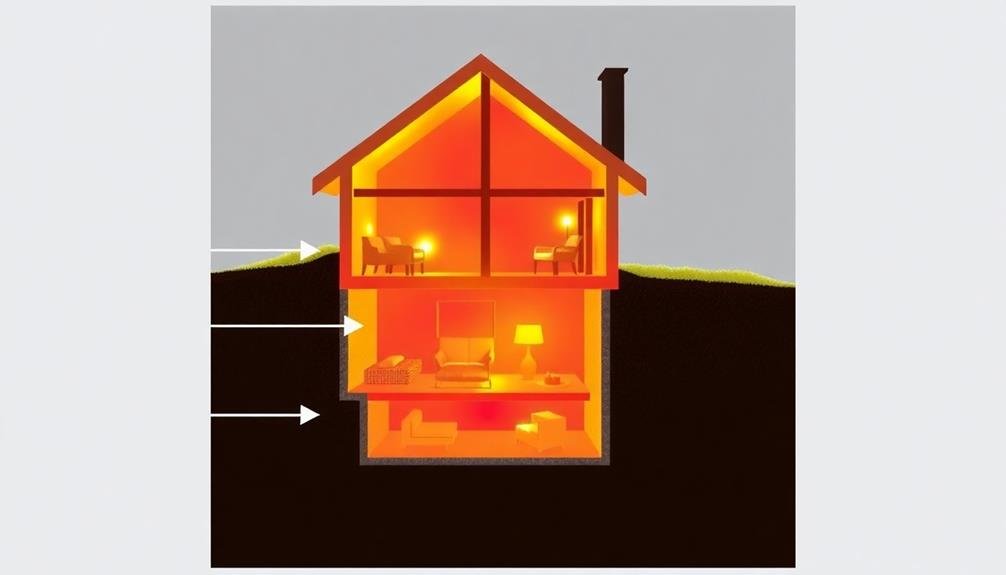
You'll find significant energy efficiency benefits when living in an underground home.
Your heating costs will be particularly lower due to the earth's insulating properties, while your cooling needs will be drastically reduced during hot summer months.
These homes maintain consistent indoor temperatures year-round, ensuring comfort without excessive energy consumption.
Lower Heating Costs
One of underground homes' most significant advantages is their ability to substantially reduce heating costs. You'll find that the earth surrounding your home acts as a natural insulator, maintaining a stable temperature year-round. This means you won't need to rely as heavily on artificial heating systems during colder months, resulting in substantial energy savings.
The lower heating costs of underground homes can be attributed to several factors:
- Thermal mass: The soil surrounding your home absorbs and retains heat, creating a buffer against temperature fluctuations.
- Reduced surface area: With less exposed exterior, there's less opportunity for heat loss through walls and roofs.
- Natural geothermal heating: The earth's constant temperature helps warm the home from below.
- Minimal air infiltration: Fewer windows and doors mean less cold air seeping in.
You'll appreciate how these features work together to keep your home comfortable without straining your heating system.
As energy prices continue to rise, you'll find that your underground home's lower heating costs become an increasingly valuable asset. By reducing your reliance on traditional heating methods, you're not only saving money but also decreasing your carbon footprint.
Reduced Cooling Needs
Just as underground homes excel at reducing heating costs, they're equally impressive when it comes to cooling. You'll find that the earth's natural insulation keeps your underground home notably cooler during hot summer months. The surrounding soil acts as a thermal mass, absorbing excess heat and maintaining a stable temperature year-round.
You won't need to rely heavily on air conditioning systems, as the temperature underground remains relatively constant. This means you'll save on both energy consumption and cooling costs. The depth of your home plays an essential role in its cooling efficiency, with deeper structures benefiting from even more stable temperatures.
Here's a breakdown of temperature variations at different depths:
| Depth (feet) | Summer Temp (°F) | Winter Temp (°F) | Temp Variation (°F) |
|---|---|---|---|
| Surface | 80-100 | 30-50 | 50-70 |
| 5 | 72-80 | 45-55 | 25-27 |
| 10 | 70-75 | 50-55 | 20 |
| 20 | 65-70 | 55-60 | 10 |
| 30+ | 55-65 | 55-65 | 0-10 |
As you can see, the deeper your home, the more stable and cooler the temperature becomes, reducing your need for artificial cooling systems.
Consistent Indoor Temperatures
A major advantage of underground homes is their ability to maintain consistent indoor temperatures year-round. You'll find that these subterranean dwellings naturally resist temperature fluctuations, providing a comfortable living environment without excessive heating or cooling. The earth's thermal mass acts as a buffer, absorbing and releasing heat slowly, which helps stabilize indoor temperatures.
This consistency offers several benefits:
- Enhanced comfort: You won't experience sudden temperature changes or drafts common in above-ground homes.
- Reduced energy costs: Your heating and cooling systems won't need to work as hard to maintain desired temperatures.
- Improved sleep quality: A stable environment promotes better rest and overall well-being.
- Extended equipment lifespan: Less frequent cycling of HVAC systems reduces wear and tear.
You'll appreciate the steady climate in your underground home, especially during extreme weather events. While surface temperatures may swing wildly, your subterranean retreat remains relatively unaffected.
This stability not only contributes to your comfort but also helps protect your belongings from temperature-related damage. By choosing an underground home, you're investing in a living space that naturally regulates its temperature, providing year-round comfort and energy efficiency.
Minimal Temperature Fluctuations
Nearly all underground homes boast minimal temperature fluctuations throughout the year.
You'll find that these structures maintain a remarkably stable indoor climate, with temperatures varying by only a few degrees between seasons. This consistency is due to the earth's natural insulating properties, which shield the home from extreme outdoor temperature changes.
In an underground home, you won't experience the sudden temperature drops or spikes common in above-ground houses.
The surrounding soil acts as a thermal buffer, slowly absorbing or releasing heat. This means you'll enjoy a comfortable environment without relying heavily on heating or cooling systems.
You'll notice that even during the hottest summer days or coldest winter nights, your underground home's temperature remains relatively constant.
This stability eliminates the need for frequent thermostat adjustments and reduces the strain on your HVAC system. As a result, you'll save energy and money while maintaining a consistently comfortable living space.
The minimal temperature fluctuations in underground homes also contribute to better indoor air quality and reduced humidity levels, creating a healthier living environment for you and your family.
Cooling Without Air Conditioning
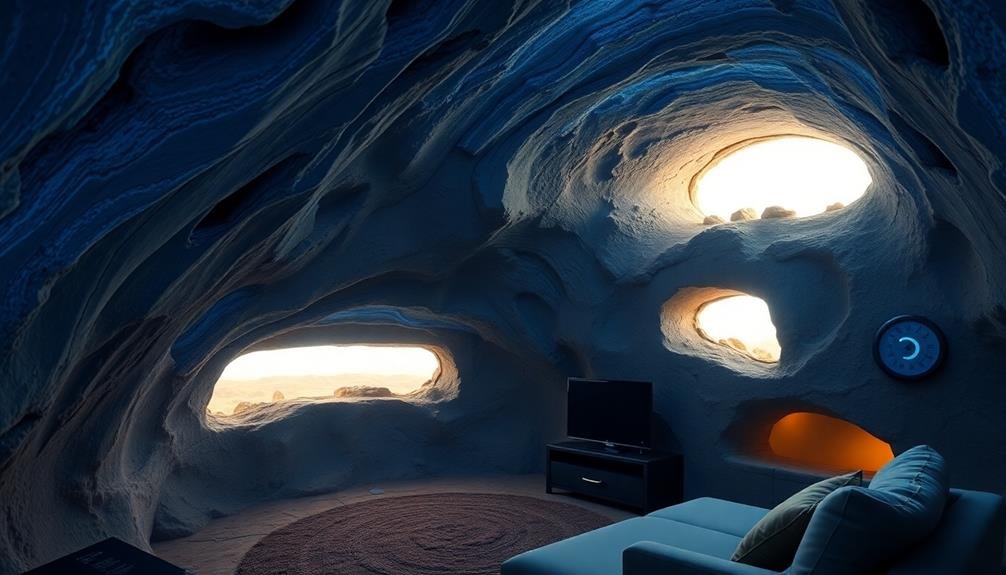
You'll find that underground homes naturally stay cool without the need for air conditioning. The earth's soil acts as a natural insulator, keeping the interior temperature stable and comfortable even during hot summer months.
Additionally, you can enhance this cooling effect by incorporating geothermal cooling systems, which utilize the constant temperature of the earth to further regulate your home's climate.
Earth's Natural Insulation
One of nature's most effective cooling systems lies right beneath our feet. The earth's natural insulation properties make it an ideal medium for regulating temperature in underground homes. As you descend below the surface, you'll find that the ground maintains a relatively constant temperature year-round, typically ranging from 50-60°F (10-15°C) depending on your location.
This natural insulation works in your favor by:
- Providing a thermal buffer against extreme outdoor temperatures
- Reducing the need for artificial heating and cooling systems
- Minimizing temperature fluctuations throughout the day and seasons
- Offering protection from harsh weather conditions
You'll find that underground homes can take full advantage of this natural phenomenon. The surrounding earth acts as a massive heat sink, absorbing excess heat during hot periods and releasing it when temperatures drop.
This process helps maintain a comfortable indoor environment with minimal energy input.
Geothermal Cooling Systems
Geothermal cooling systems harness the earth's natural temperature to cool underground homes without traditional air conditioning. These systems work by circulating fluid through pipes buried in the ground, where temperatures remain constant year-round. As the fluid moves through the cooler earth, it sheds heat and returns to the home at a lower temperature.
You'll find that geothermal cooling is highly efficient and environmentally friendly. It uses minimal electricity, mainly to power the circulation pumps. This results in considerably lower energy bills compared to conventional air conditioning. The system's components are also long-lasting, with underground pipes often lasting 50 years or more.
In an underground home, you can integrate geothermal cooling with the structure's natural thermal mass. The cool air from the system is distributed through the home's ductwork, working in tandem with the earth-sheltered walls to maintain a comfortable temperature.
You'll notice that this combination creates a stable, draft-free environment that's cooler in summer and warmer in winter. It's a sustainable solution that capitalizes on nature's own cooling properties, making your underground home even more energy-efficient and comfortable.
Winter Warmth Retention
During winter months, underground homes excel at retaining warmth. You'll find that the earth surrounding your home acts as a natural insulator, keeping the interior cozy even when temperatures plummet outside. This thermal mass effect means you'll use less energy to maintain a comfortable living environment, reducing your heating costs and carbon footprint.
Underground homes benefit from several factors that contribute to their superior winter warmth retention:
- Constant ground temperature: The earth maintains a relatively stable temperature year-round, providing a buffer against extreme cold.
- Reduced surface area: With fewer walls exposed to the elements, there's less opportunity for heat loss through conduction.
- Natural wind protection: Being underground shields your home from chilling winter winds, eliminating drafts and heat loss through convection.
- Passive solar design: Properly oriented windows and thermal mass can capture and store solar heat, supplementing your heating system.
You'll appreciate how these features work together to create a warm, energy-efficient living space. By harnessing the earth's natural insulating properties, you're able to stay comfortable throughout the winter while minimizing your reliance on artificial heating systems.
Geothermal Heat Exchange Potential
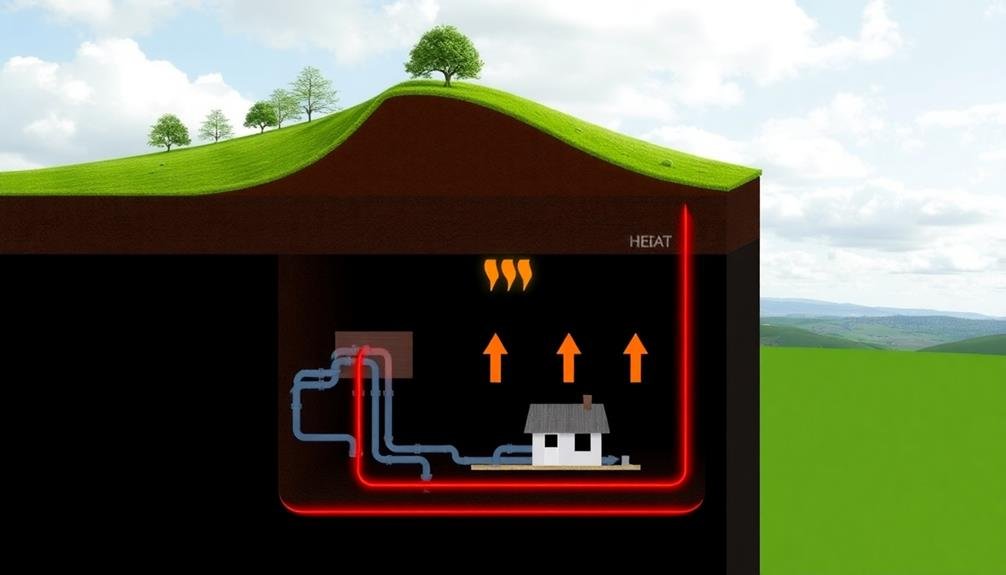
Underground homes frequently offer excellent potential for geothermal heat exchange systems. These systems take advantage of the Earth's stable temperature below the frost line, typically around 50-60°F (10-15°C) year-round. By tapping into this constant temperature, you can considerably reduce your heating and cooling needs.
In an underground home, you're already partway there. The surrounding soil acts as a natural insulator, moderating temperature fluctuations. By incorporating geothermal heat pumps, you can enhance this effect.
These pumps circulate a fluid through pipes buried in the ground, exchanging heat with the Earth. During winter, the system extracts warmth from the ground to heat your home. In summer, it reverses, pulling heat from your home and depositing it into the cooler ground. This process is highly efficient, often providing 3-4 units of heat for every unit of electricity used.
You'll find that geothermal systems work particularly well with underground homes due to the proximity to the Earth's stable temperatures. This synergy can result in substantial energy savings and a more consistent, comfortable indoor climate throughout the year.
Frequently Asked Questions
Are Underground Homes More Susceptible to Flooding?
Yes, underground homes can be more susceptible to flooding. You'll need to take into account proper waterproofing, drainage systems, and site selection to mitigate flood risks. It's essential to consult experts and implement preventive measures when building an underground home.
How Do Underground Homes Handle Ventilation and Air Quality Issues?
You'll need a robust ventilation system for your underground home. It'll include air exchangers, dehumidifiers, and filtration units to maintain fresh air circulation. Regular maintenance is essential to prevent mold growth and guarantee good indoor air quality.
What Are the Construction Costs Compared to Traditional Above-Ground Houses?
You'll likely spend more upfront on an underground home. They're costlier to build due to excavation, waterproofing, and specialized systems. However, you'll save on energy bills long-term, potentially offsetting the initial expense over time.
Can Underground Homes Have Windows and Natural Light?
Yes, you can have windows and natural light in your underground home. You'll use skylights, light wells, or strategically placed windows on exposed sides. You'll also incorporate reflective surfaces to maximize daylight throughout your living spaces.
Are There Specific Maintenance Challenges Unique to Underground Dwellings?
You'll face unique maintenance challenges with underground homes. You'll need to be vigilant about waterproofing, moisture control, and proper ventilation. You'll also have to address potential root intrusion and guarantee adequate drainage systems are in place.
In Summary
You've discovered the hidden gem of underground living: unparalleled temperature control. By harnessing Earth's natural insulation and thermal mass, you'll enjoy consistent temperatures year-round. You'll save on energy costs, reduce your environmental impact, and say goodbye to extreme temperature swings. Whether it's staying cool in summer or cozy in winter, your underground home will keep you comfortable without relying heavily on artificial heating or cooling. It's time to embrace the subterranean lifestyle and reap its climate-regulating benefits.

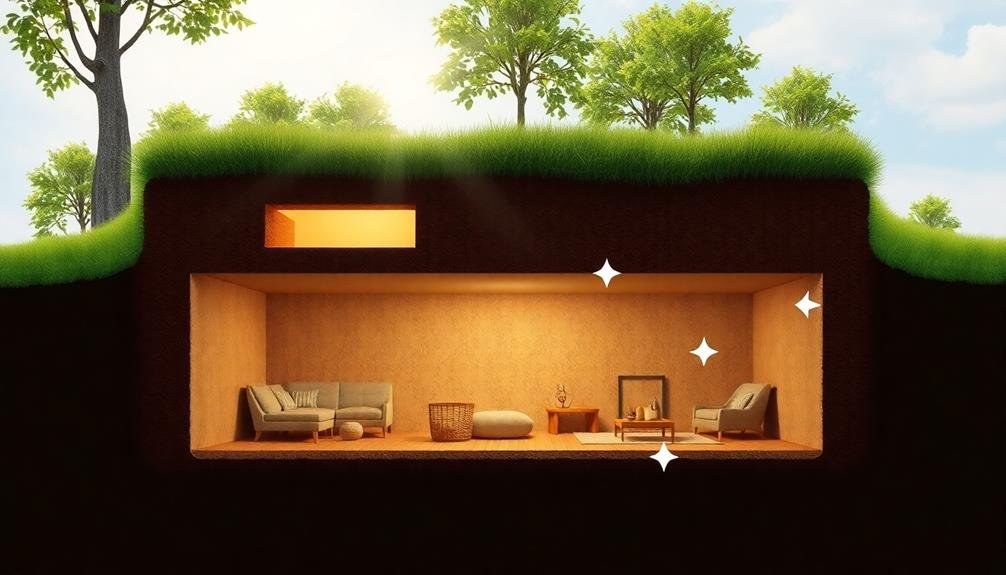

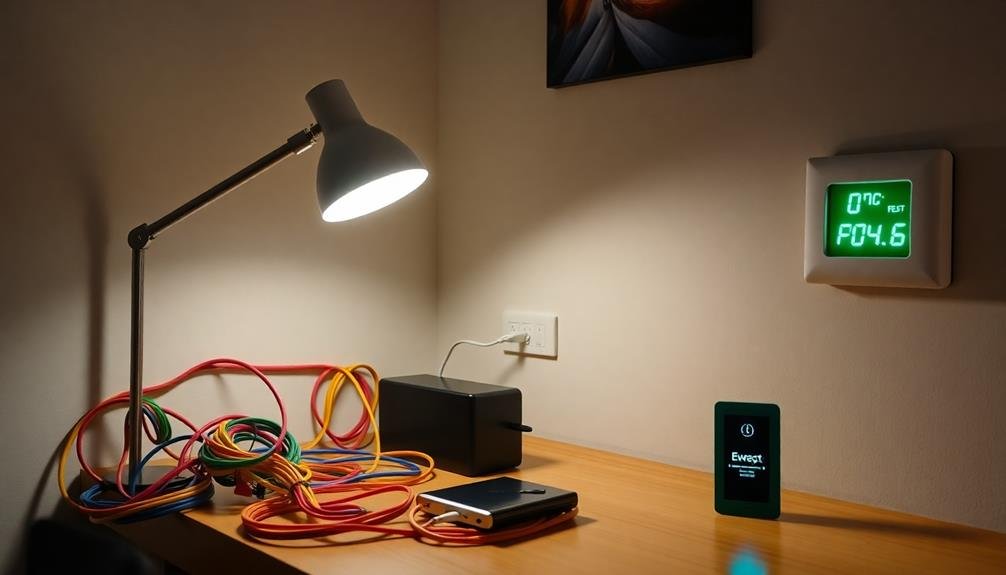
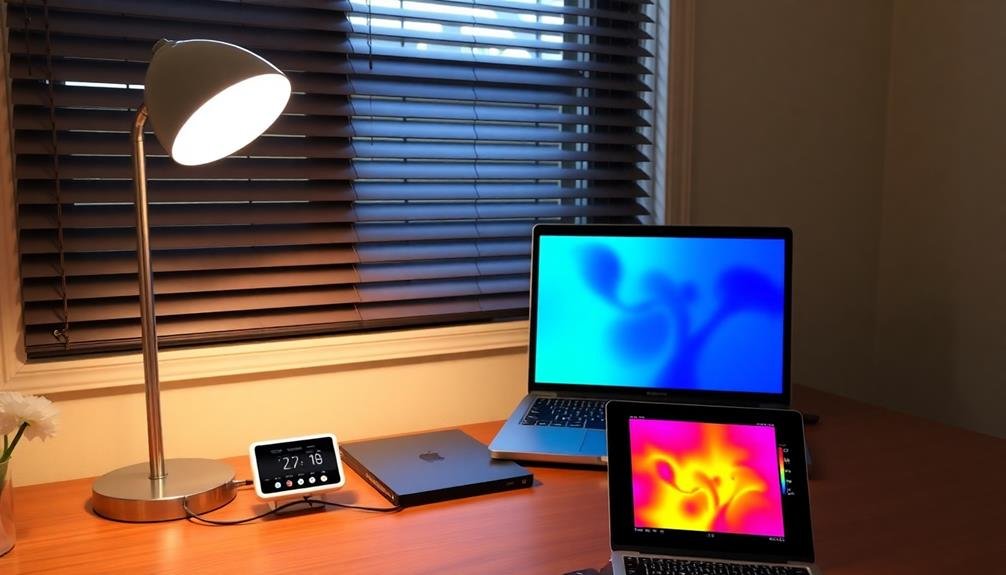
Leave a Reply